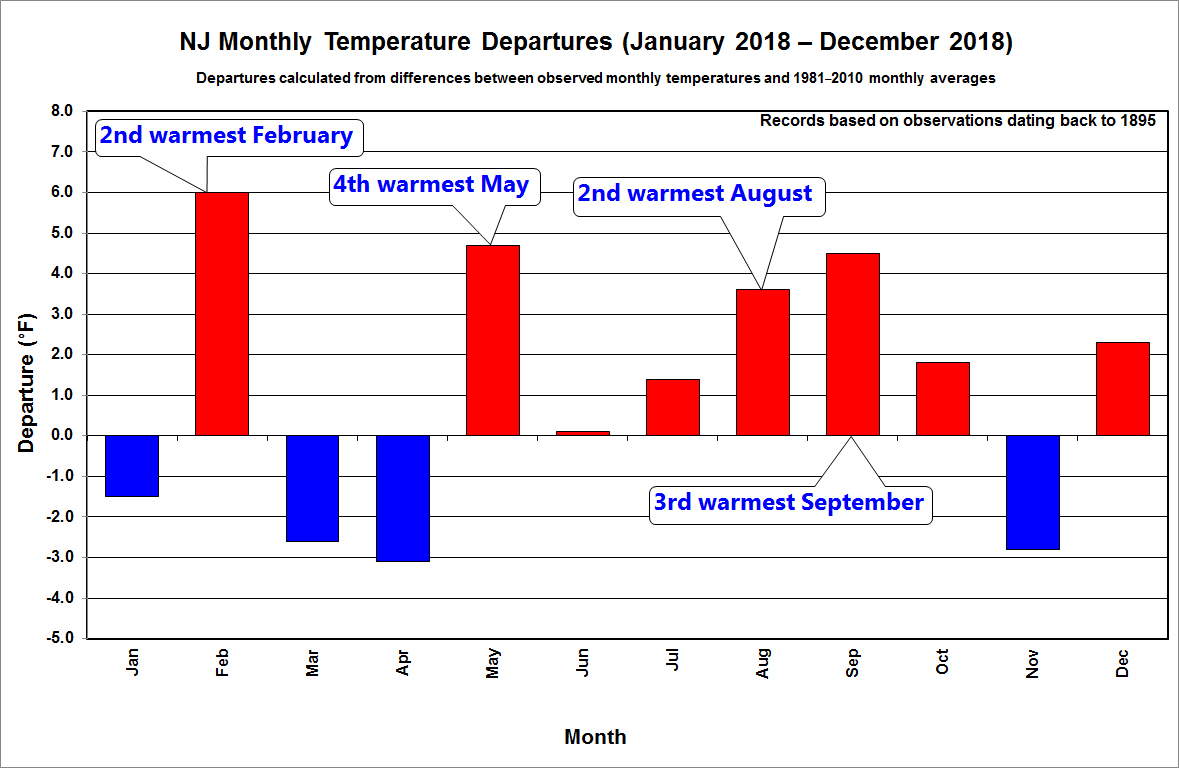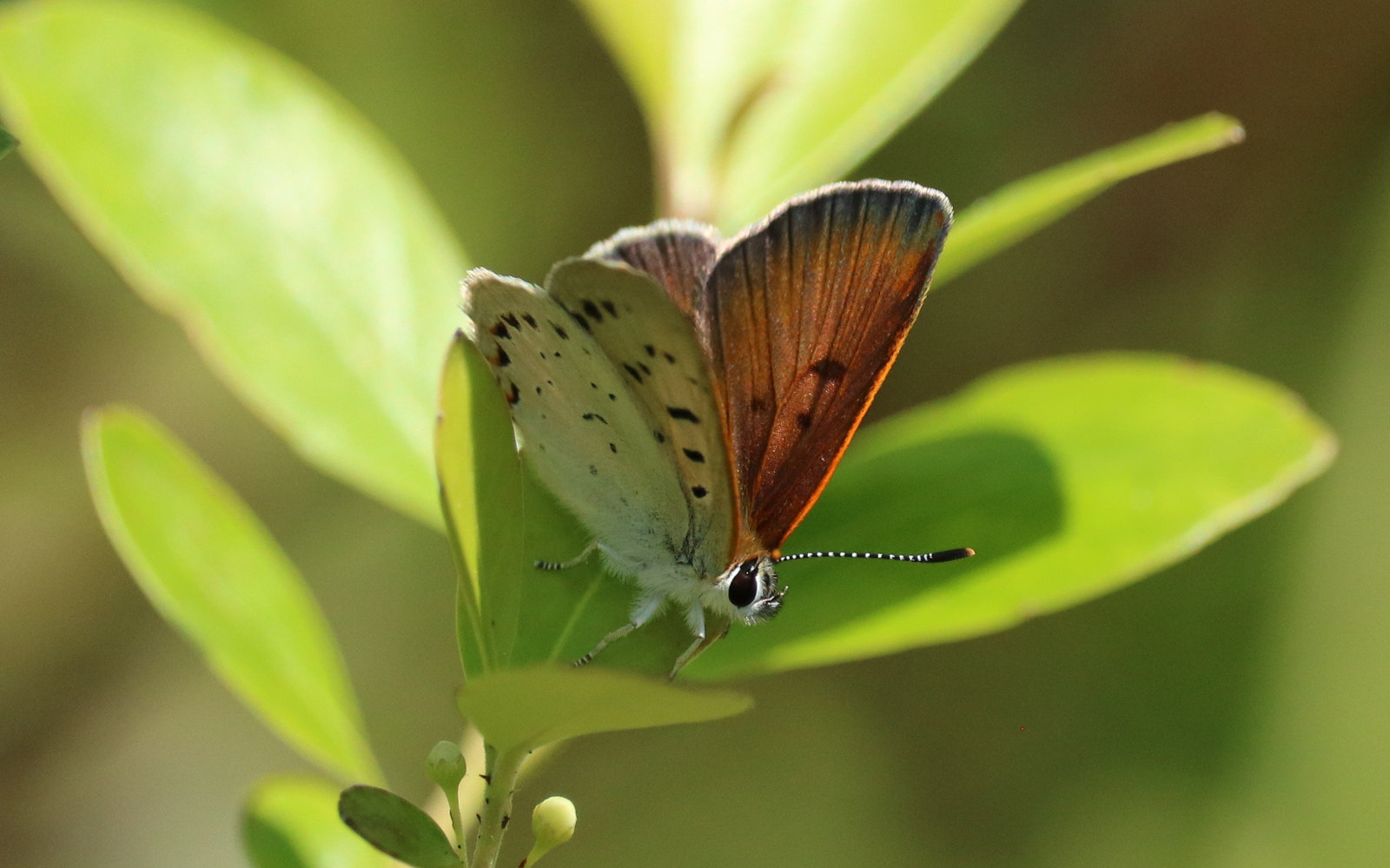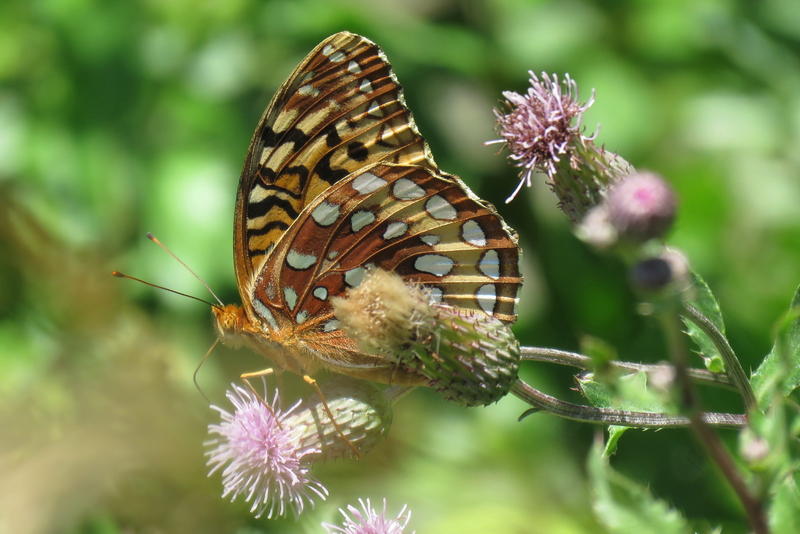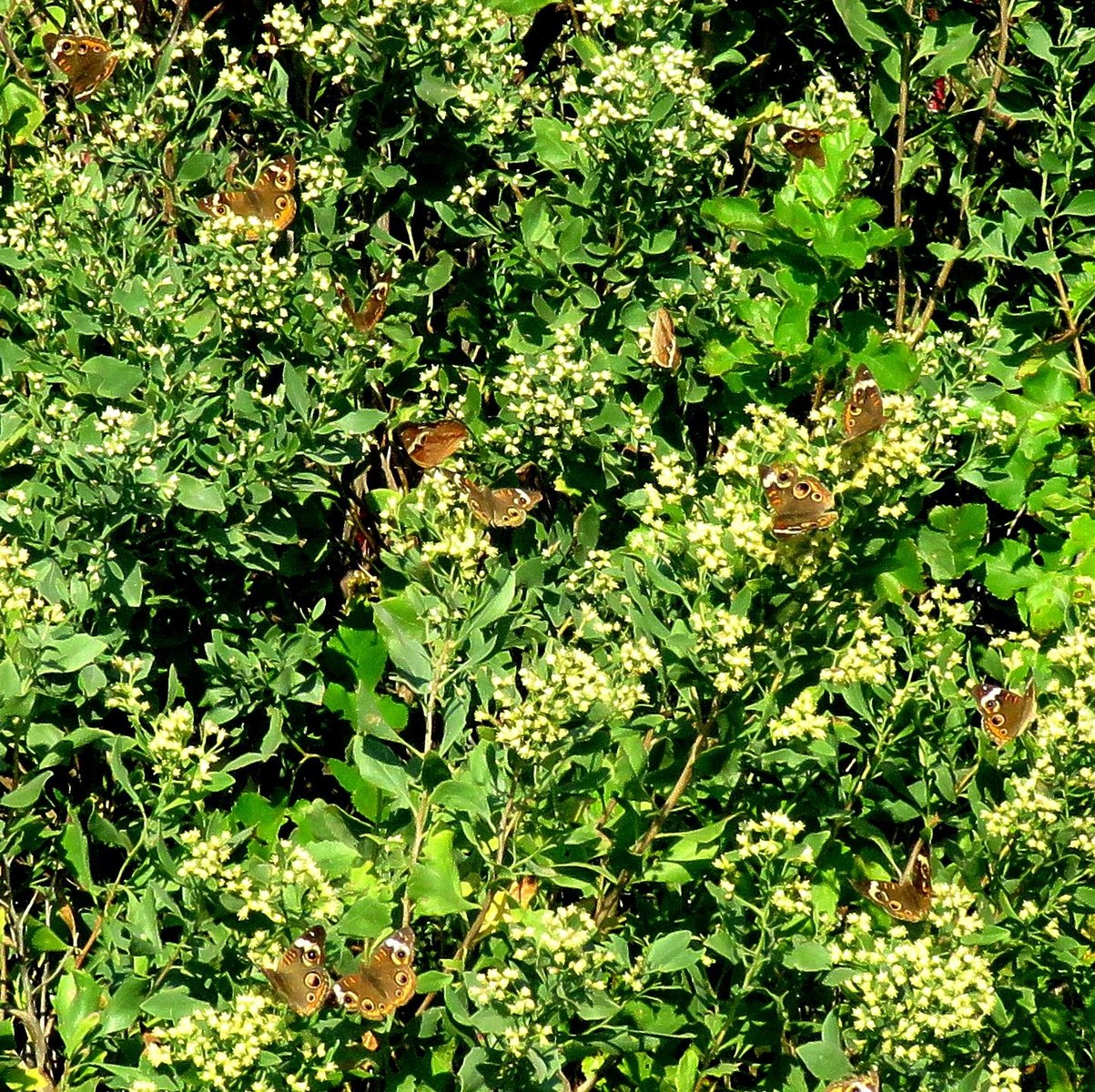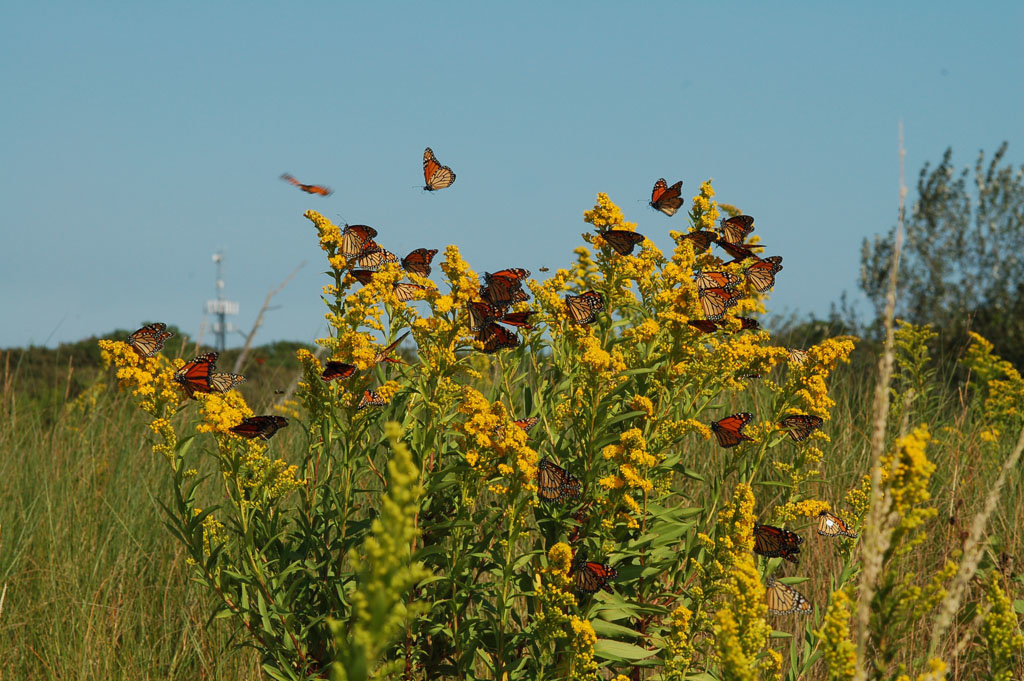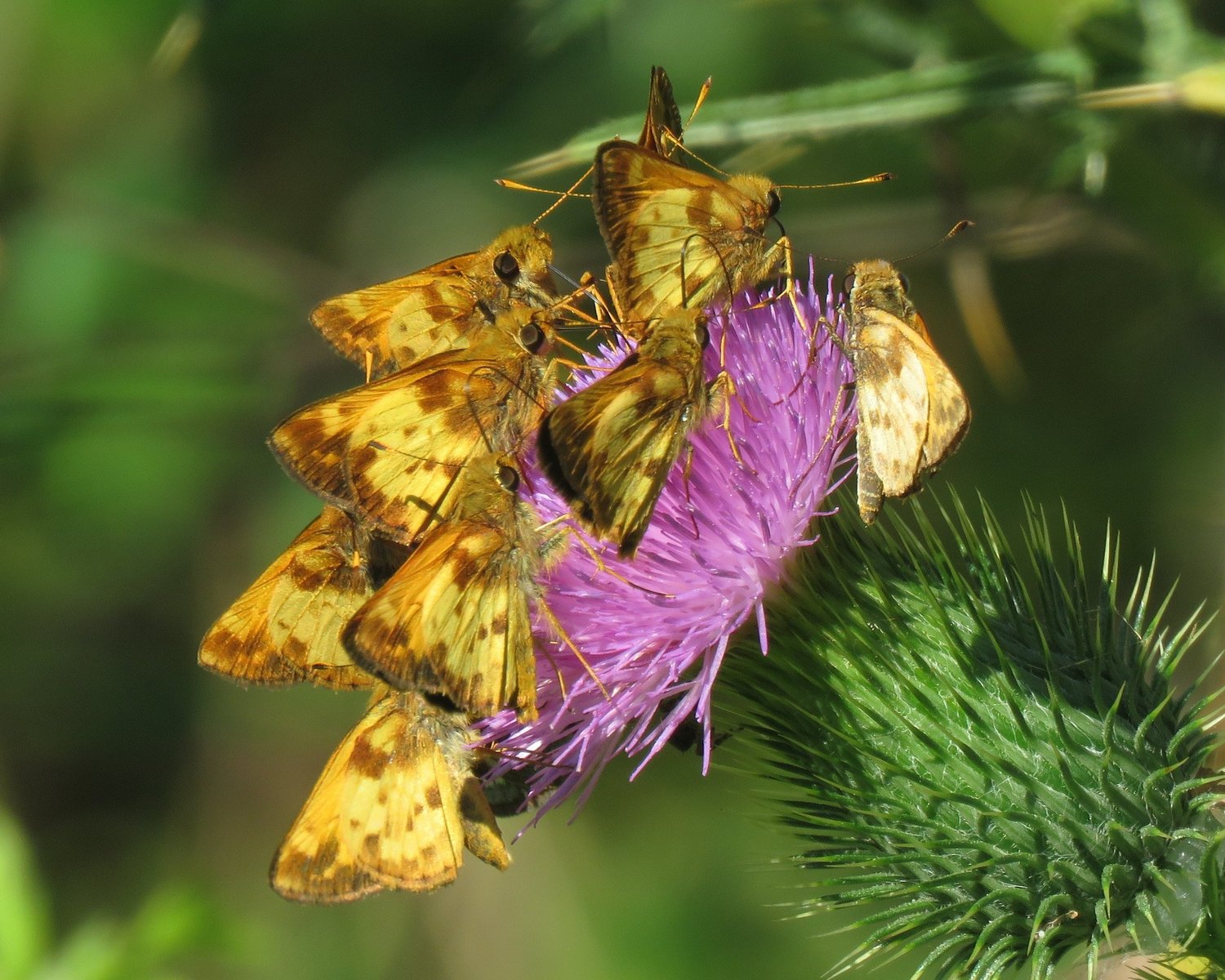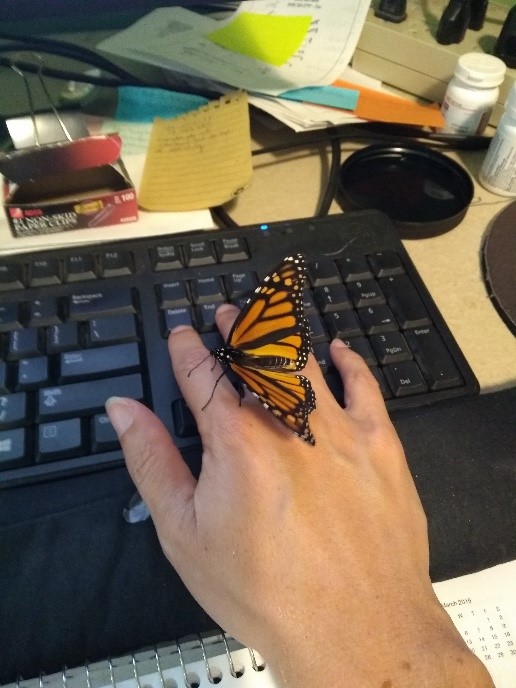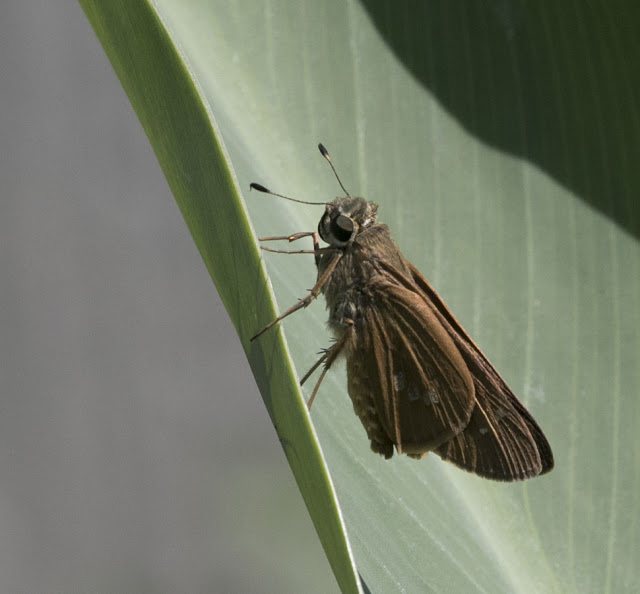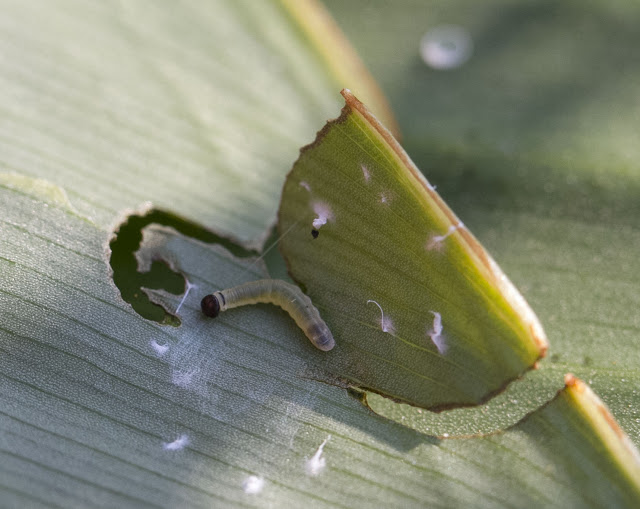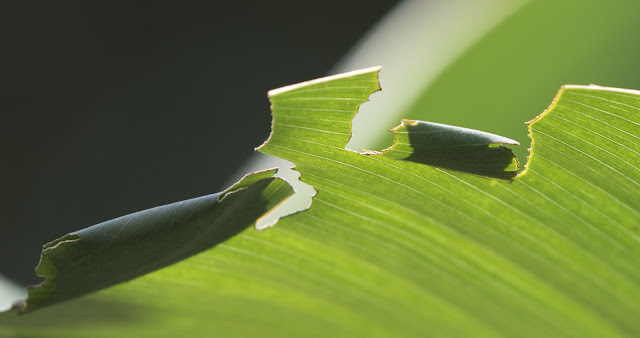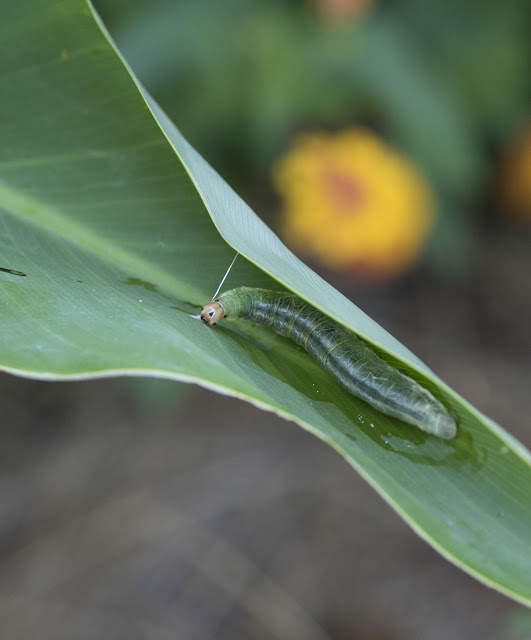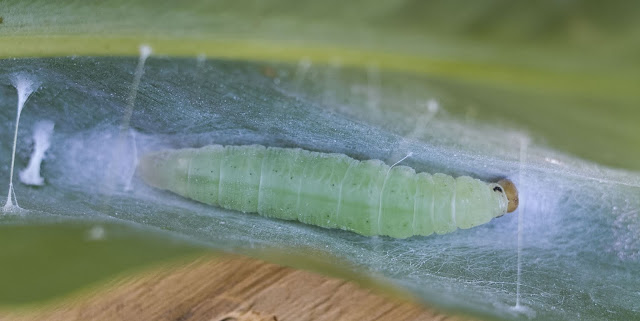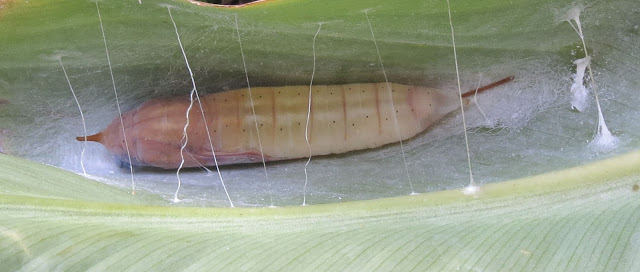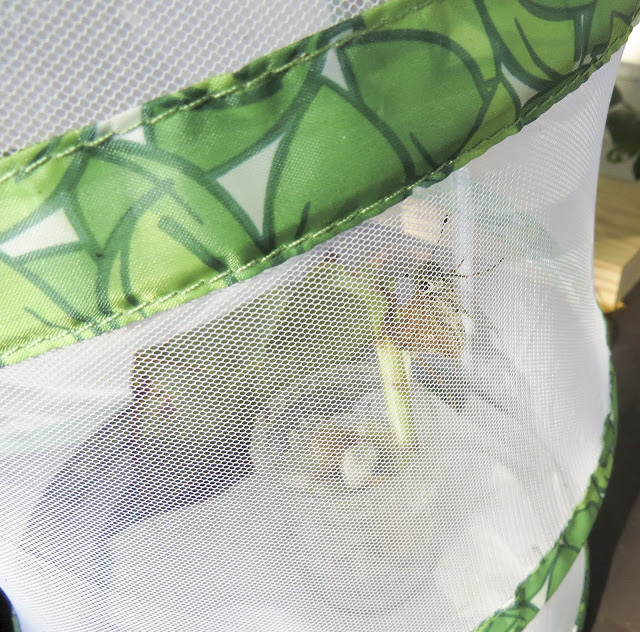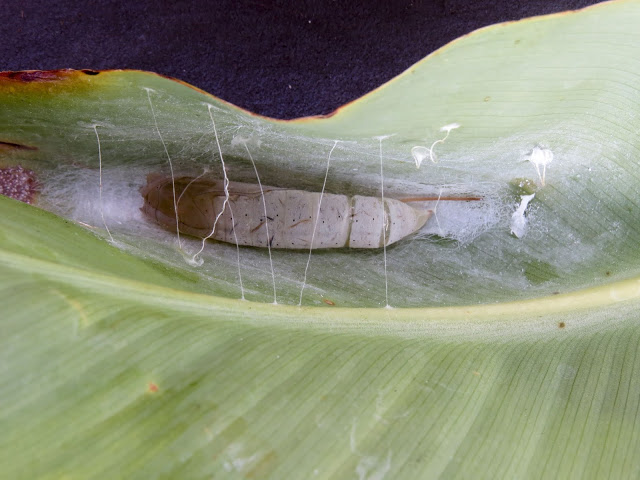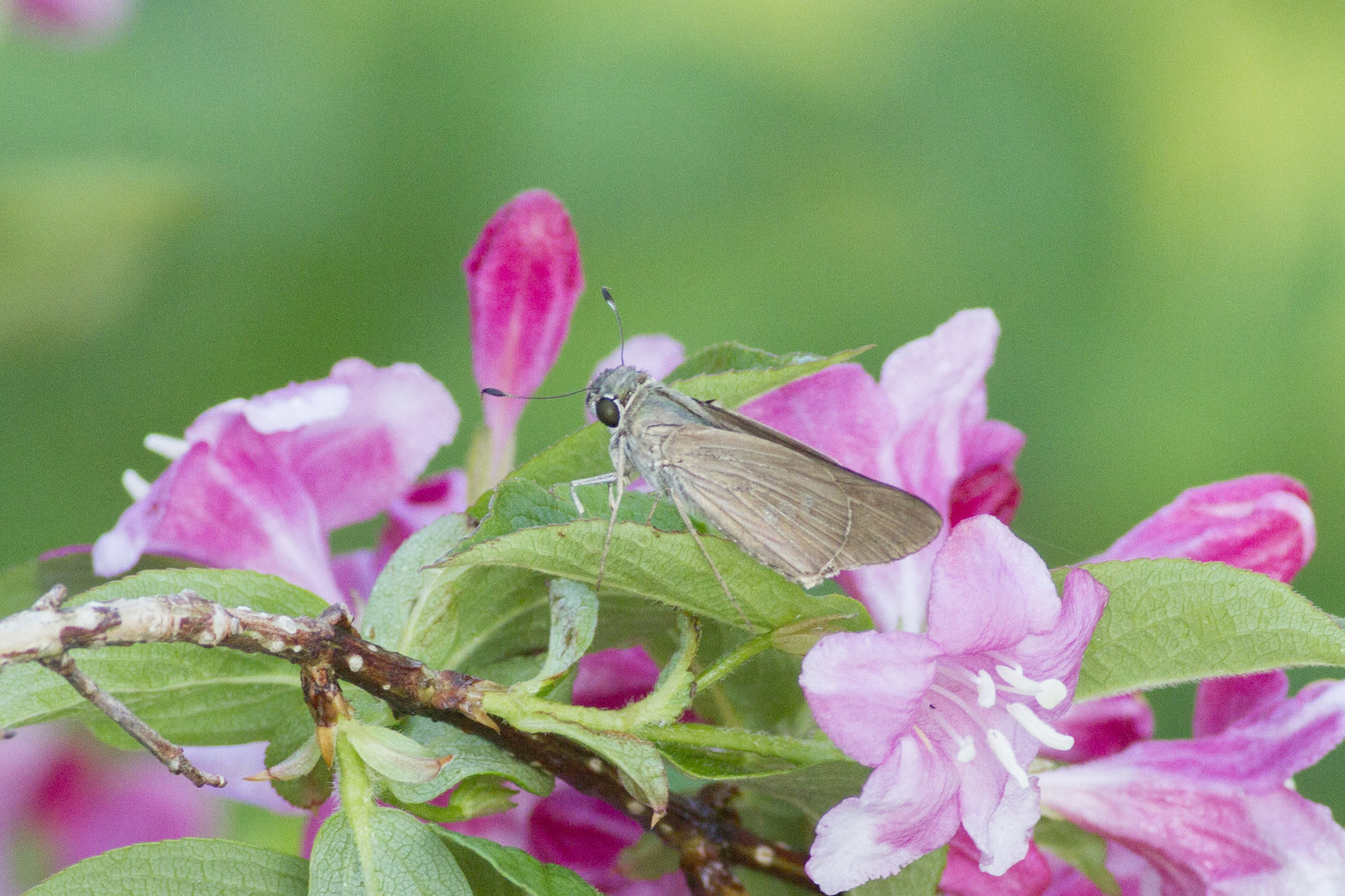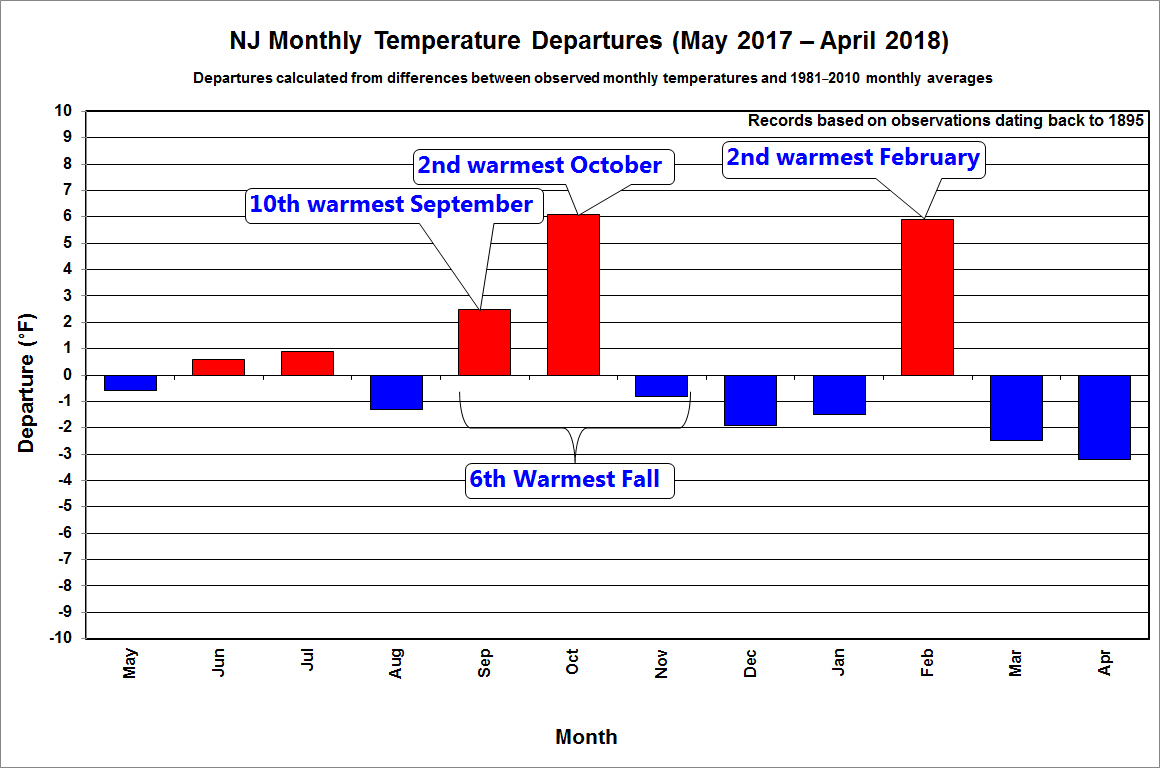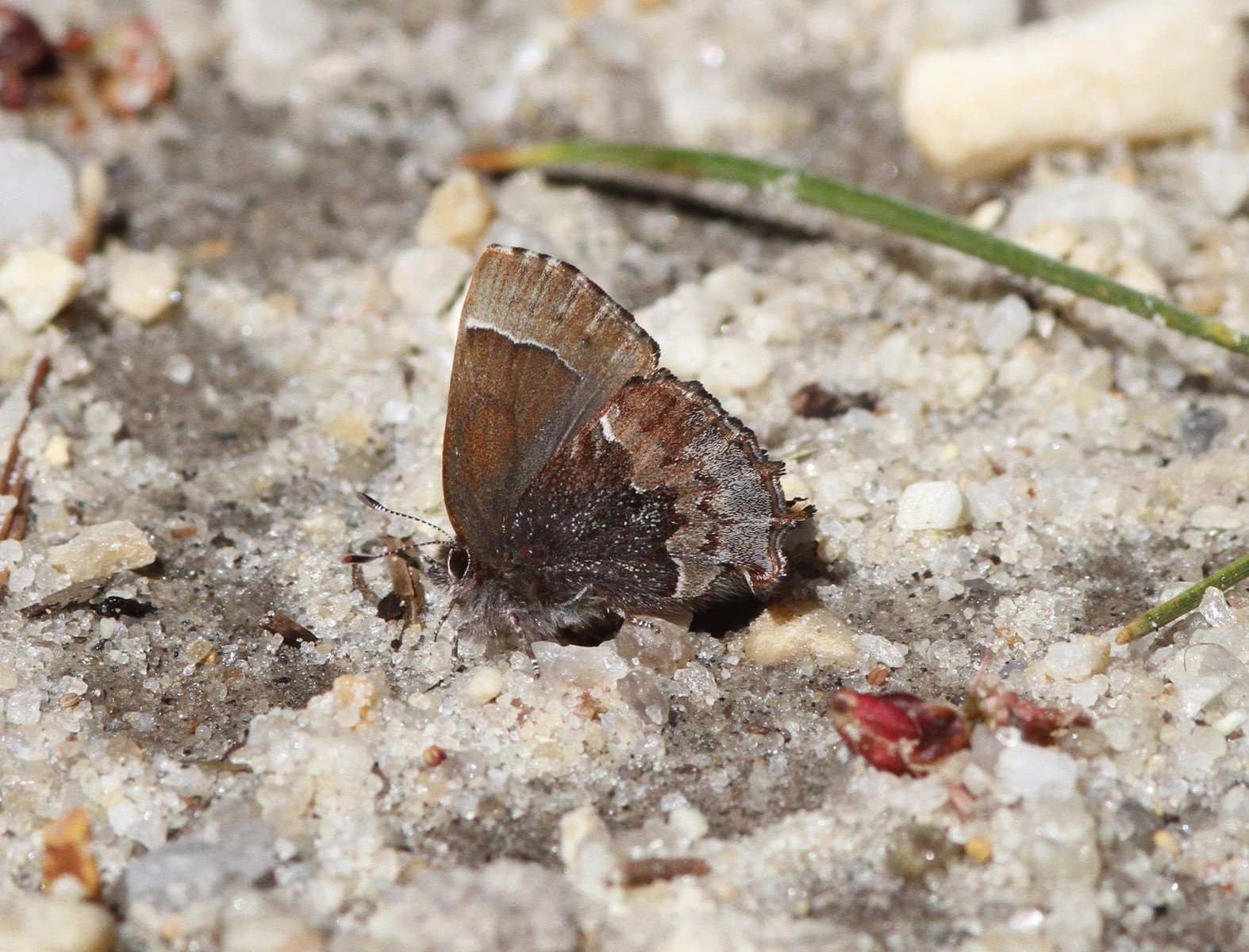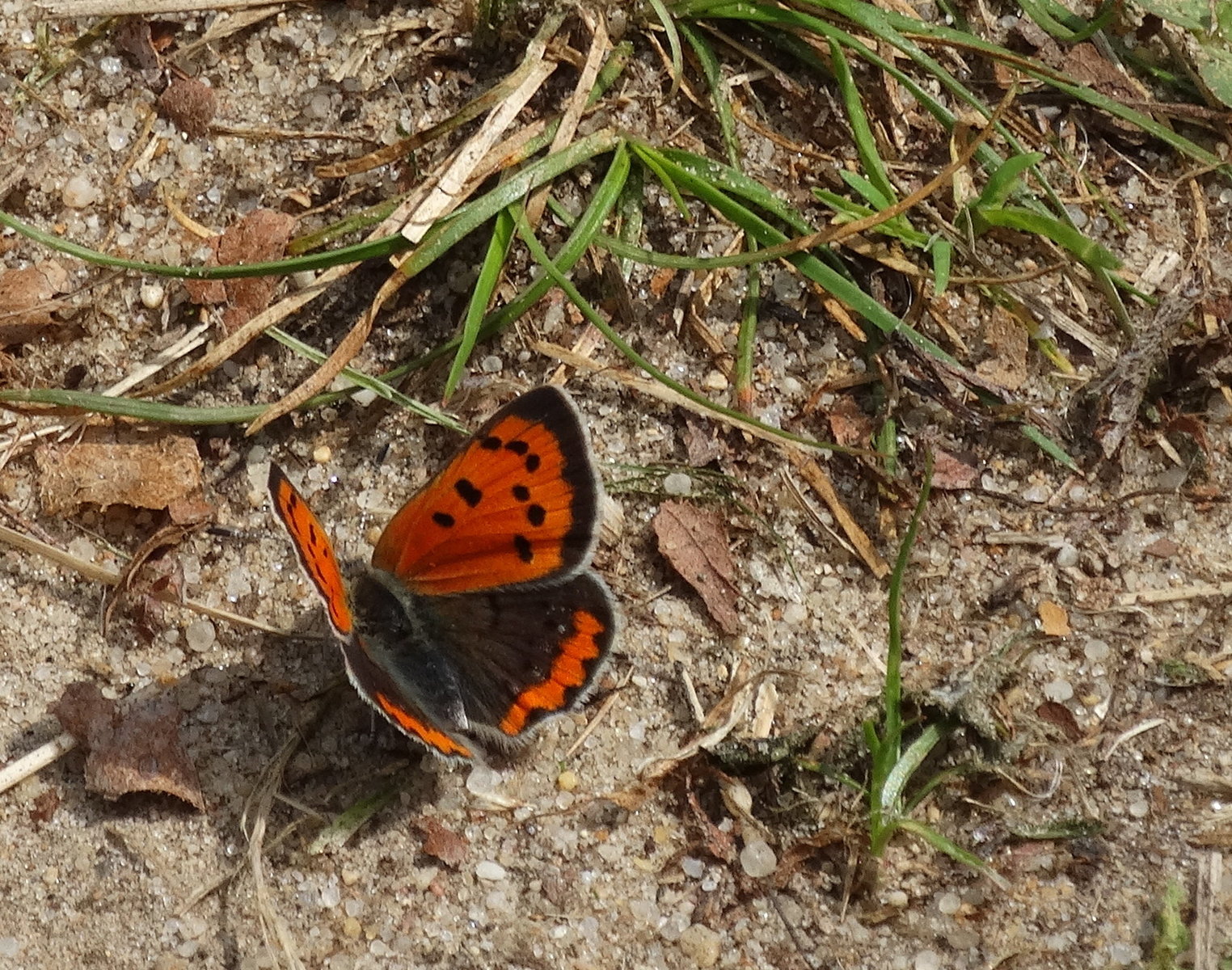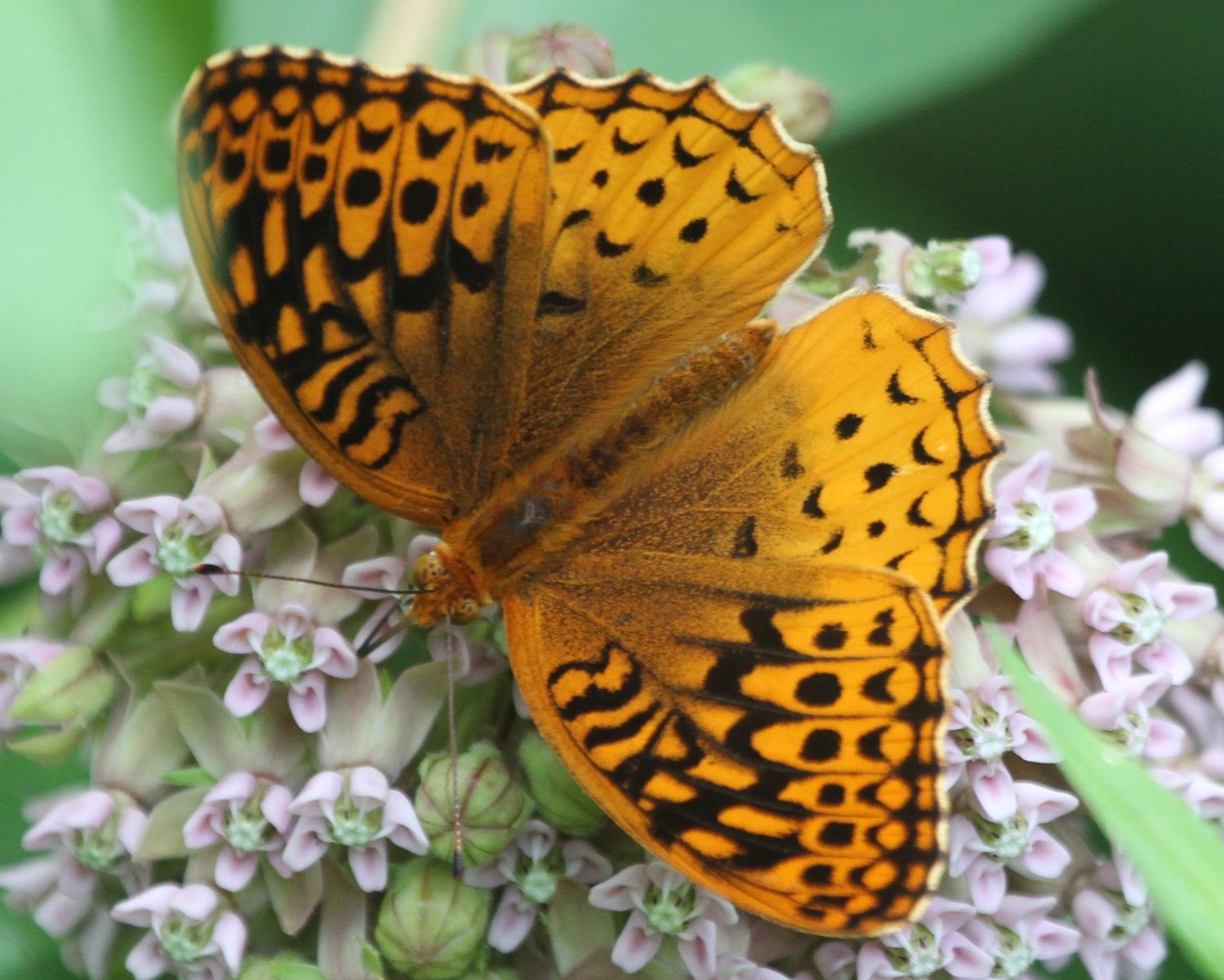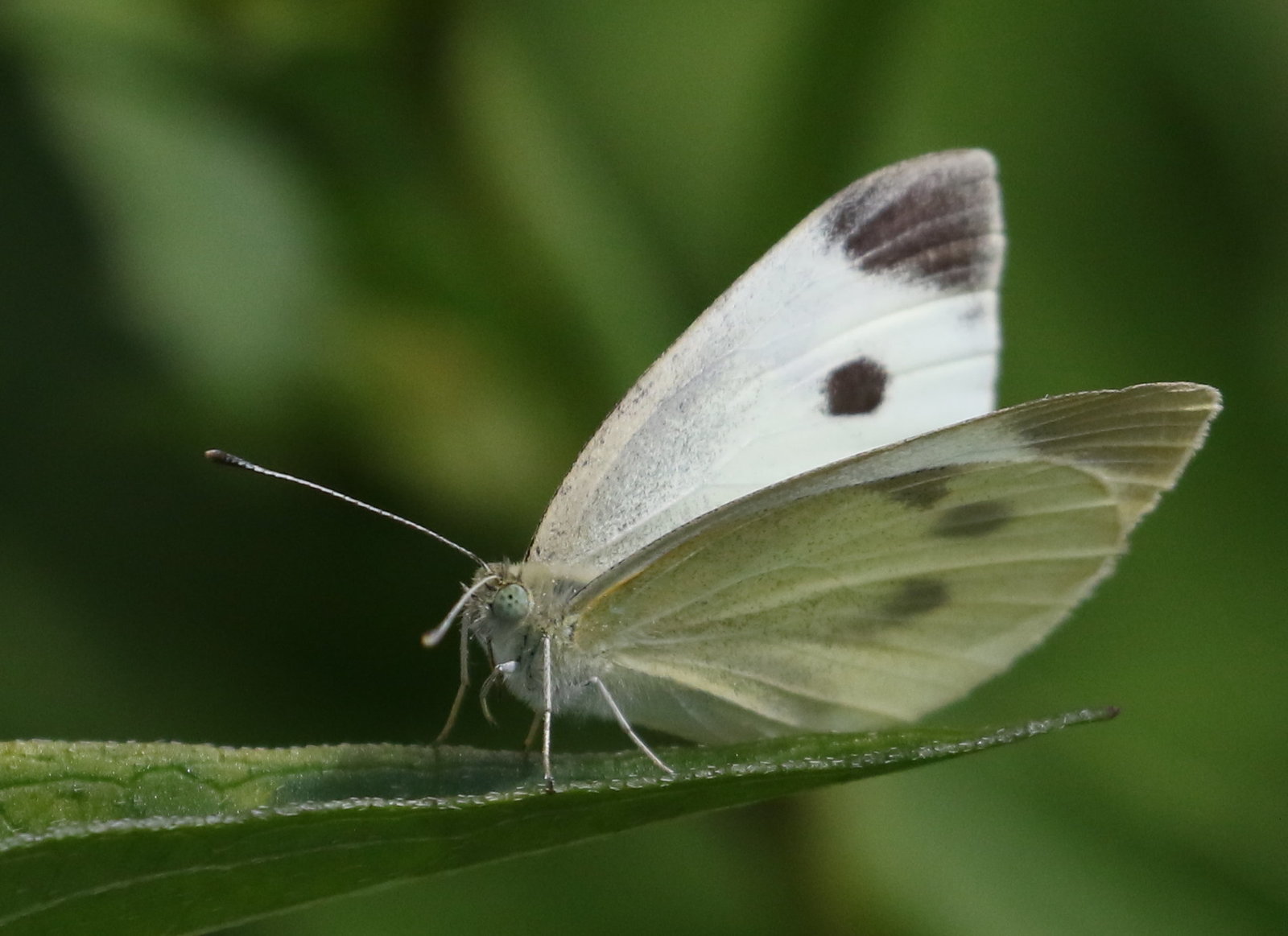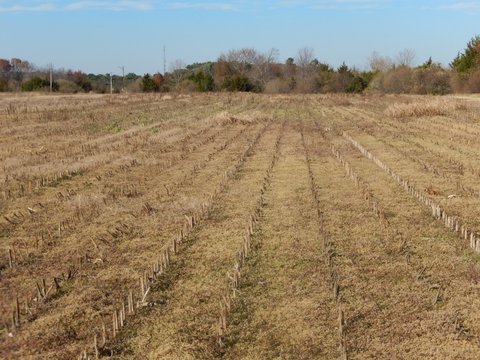
2018 was a down year for many species, but we had some superb finds to celebrate, nevertheless — including two reports of zebra swallowtail. Photo by Dolores Amesbury in her garden. See below.
First Some Good Memories:
The explosion of Brazilian skippers in CMY, in many gardens growing Canna, seems what most of us will remember longest about 2018. [See earlier posts on this blog for the details.] Stay tuned in 2019 and for the next several years to see whether the invasion of this southern vagrant was a one-time show or only a prelude of things to come.
And, meanwhile, let’s not overlook the finds of an even rarer species. We had two reports of zebra swallowtail in 2018: the first by Cynthia Allen on June 15 on the Middle Township Bike Path and a second (possibly the same individual) photographed by Dolores Amesbury on June 26 in her garden in Cape May Courthouse. We have had only one other report of this species in our log’s eleven-year history: Jim Dowdell photo’d one in his garden in Villas on June 28, 2014.
Cynthia A’s report here: Zebra swallowtail on MTBP
Dolores A’s report here: Zebra swallowtail in CMCH
Giant swallowtails were found in three counties: CAM by Chriz Herz; CMY by Harvey Tomlinson, and BUR by Fred Kahan. And Chris had two firsts for our Project: both caterpillars and chrysalises in her garden, with the chrysalises still present in October. The zebra and giant swallowtail reports meant we “swept” the swallowtails – finding all six species in a single year for only the second time in our log’s eleven years (previously only in 2014).
The sleepy orange colony at Dix WMA in CUM had an excellent year, as documented by Stephen Glynn and several other observers. We also had some evidence that this once vagrant-only species may be breeding in CMY with reports there from Jim Dowdell, Beth Polvino, and Harvey Tomlinson – all in their gardens;
The harvester colony at Chestnut Branch (GLO) also had a good year, it seems, with several reports from Dave Amadio and others. Dave’s find of two adults on 9/22/18 gave us a new latest-ever date for this species and from that date going back to Brenda Bruton’s FOY on May 24 from Boundary Creek (BUR) harvester became one of very few species this year whose flight season was longer than usual.
Georgia satyrs were found again in both first and second broods – with multiple reports from two counties (ATL and BUR) by Brian Johnson and Jack Miller;
The “white admiral” form of the red-spotted purple was found for the first time in our South Jersey Butterfly Project’s history – by Tom Bailey at Palmyra Cove Natura Park (BUR) on June 30.
Monarchs had a good to excellent fall flight – with double-digit counts in many reports and thousands seen by Pat and Clay Sutton on October 3 at Cape May Point.
Long-tailed skippers were reported in three counties: CMY (several observers), CUM (Jack Miller) and GLO (David Amadio).
Now 2018’s Downside Story:
All species have off years from time to time, but there is no other year in our log’s eleven when so many species showed such low counts. A clear majority of the ninety-one species recorded in 2018 were harder to find than usual, including many of our most reliably numerous: tiger swallowtail, spicebush swallowtail, cabbage white, orange sulphur, American copper, red-banded hairstreak, gray hairstreak, eastern tailed-blue, pearl crescent, American lady, red admiral, Horace’s duskywing, salt-marsh skipper, sachem, and others.
To make the year’s generally pitiful numbers more obvious, they are contrasted in the “Individual Species Compilations” with the 2016 counts (a more normal year). When 2018’s numbers for a species were less than half those in 2016 this is noted at the end of the entry for each species. Fifty-three species had totals that low.
Swallowtails: tiger and spicebush
Whites: cabbage and checkered
Sulphurs: little yellow, cloudless and orange sulphurs
Coppers: American and bog coppers
Hairstreaks: Red-banded, banded, striped, white-m, and gray
Elfins: brown, Henry’s, frosted, and eastern pine
Blues: eastern tailed-blue, blueberry azure and holly azure.
Nymphalids: American snout, pearl crescent, mourning cloak, American lady, red admiral, red-spotted purple, hackberry and tawny emperors, Appalachian brown, and common wood-nymph.
Spread-winged Skippers: long-tailed skipper, southern and northern cloudywings, sleepy, Juvenal’s, Horace’s, and wild indigo duskywings, common checkered skipper, and common sootywing.
Grass Skippers: zabulon, salt-marsh, Aaron’s, European, fiery, Peck’s, tawny-edged, crossline, northern broken-dash, sachem, mulberry-wing, dion, and Ocola.
In the “Individual Species Compilations” we also list LFOYs and ELOYs: species whose emergences were the latest we have recorded (= Late First Of Year) and those whose last recorded flights were the earliest we have ever recorded (= Early Last Of Year). Combined, these notes suggest how the butterfly year was generally shortened from both directions. It started slowly and ended fast.
Apparently, our weather depressed butterfly numbers through the whole butterfly season. What other variable could affect so many different species? But weather sketched a complicated story in 2018, and it’s not easy to draw single lines of cause and effect.
Was It The Cold?
Here are the state-wide temperature patterns as compiled by the Office of the NJ State Climatologist, David Robinson, at Rutgers University:
The cold early spring (March and April) was almost certainly the cause of the delay of first emergences of our earliest flyers. Adult butterflies need to find sufficient solar radiation to warm up to fly and those opportunities were less available than usual. We also had four nor’easters in South Jersey in March, including a heavy snowstorm on March 21 (up to 12” in some areas), that probably directly killed at least some over-wintering adults – mourning cloaks, question-marks, eastern commas, and possibly others (red admiral? common buckeye?). That cold and snow almost certainly also killed some cabbage whites, blueberry azures, eastern tailed-blues, and others that usually eclose and first fly in March.

The storms of March almost certainly killed some of our early emerging butterflies. This azure was photo’d by Jack Miller at MacNamara WMA two days after the heavy snow. Did it survive?
Four of our five elfins (all but hoary) had counts lower than in 2016. March and April’s cold was almost certainly a factor in the depressed numbers of those early spring flyers.
But could that March and April cold be the main cause of the low numbers of so many other species for the rest of the year?
Many SJ butterflies (especially non-skippers) over-winter in the pupal state and do not eclose in numbers until mid- to late-April or later. It would seem those species especially would be little affected by nor’easters or snows of March or even a cold April. (And a late leaf-out would be less likely to affect them than species that overwinter as cats or eggs.) But many of pupal-stage over-winterers were down in numbers in 2018: e.g. spicebush swallowtail, American copper, gray hairstreak, American lady, and red admiral.
The abnormal cold drew to a close during the last ten days of April – when we had a sudden outburst of overdue spring flyers (tiger swallowtail, elfins, falcate orangetips, Juvenal’s duskywing, and others).
Then, as Robinson’s chart indicates, from May through October South Jersey became significantly warmer than usual
Was It The Heat?
State-wide the month of May averaged nearly 5 degrees warmer than average – NJ’s 4th warmest May on record (going back to 1895). Most of the rest of the year was also warmer than average with the last months of summer especially warm: August and September were the 2nd-warmest August and 3rd-warmest September ever recorded.
Our local conditions basically matched the state-wide pattern. The Atlantic City Press meteorologist, Joe Martucci, reported that based on records from the A.C. Airport, 2018’s year-long average temperature of 56.8 made it the 3rd-warmest year locally since 1943, when record-keeping began at the airport.
Could the hot weather have depressed butterfly numbers? Extra warmth is not usually considered a problem for butterflies in any of their four stages of growth. When temperatures move into the mid- to upper-90s, adults seem to retreat out of the sun. But those temperatures don’t kill them, as far we know, and as soon as the afternoon cools, they generally come out flying again.
It’s also hard to understand how extra heat would adversely affect eggs, cats, or chrysalises.
Was It The Rain?
Rain seems a more likely primary culprit than cold or heat because 2018 was unquestionably a much wetter year than average, both state-wide and locally — and the extra precipitation fell through most months of the year. Here’s David Robinson’s chart of the state-wide precipitation patterns:
According to Joe Martucci’s A.C. Press report, more than 66 inches of rain fell through the year at the A.C. Airport – approximately twenty inches more than in a typical year – making it the wettest local year since records began in 1943.
Rain prevents butterflies from flying as often as they might otherwise, of course. That could limit their chances to find mates and so theoretically, at least, depress the number of eggs laid and then depress subsequent caterpillar and adult survival. Caterpillars also can be directly affected by excessive rain if it limits their ability to feed as much as they should. Inactivity by both adults and cats might be especially evident in the low numbers seen in double- and triple-brooded species – tiger and spicebush swallowtails, American copper, Horace’s and wild indigo duskywings, and others.
Rain can also injure or kill adult butterflies directly. Michael Raupp, entomologist at the University of Maryland, writes on the Scientific American website:
“An average monarch weighs roughly 500 milligrams; large raindrops have a mass of 70 milligrams or more. A raindrop this size striking a monarch would be equivalent to you or me being pelted by water balloons with twice the mass of bowling balls.”
Climatologist Robinson notes on his annual report that much of the state’s rain came this year in heavy deluges: “2018 will be remembered for storm after storm after storm.” NJ had eleven days with more than 4 inches of rain fell in less than 24 hours – in at least one station and usually many more. Six of the ten heaviest daily rain falls were recorded at stations in our eight-county area. On 8/16/19 6.98 inches of rain fell at a station in Lakewood Township (OCN) in less than 24 hours. On 10/12/19 a station in Southhampton (BUR) measured 6.52 inches of rain in 24 hours.
Could heavy and wide-spread deluges have killed a significant number of adults directly and so contributed to the shortened fall season? It seems likely.
Also, Possibly, “Observer Effect”?
All three weather abnormalities – March and April’s extra cold, May to September’s extra heat, and the heavy rains through many months – probably had at least some effect on everyone’s get-up-and-go. It is simple human nature that butterfly excursions tend to be shorter and fewer when butterflies are down, which leads to fewer butterflies to report – and so pushes total numbers still farther down.
An Optimistic Guess About 2019:
Because they breed so prolifically, insects usually recover quickly from down years – especially when the causes were natural events.
At first 2019 might start slowly. We may have another year of low counts in early-season single-brooded species (azures, elfins, Juvenal’s skipper, et al) because last year’s adults were few. And we may also see fewer first-brood individuals of multi-brooded species (tiger and spicebush swallowtails, Horace’s and wild indigo duskywings, and so on) because their last brood flight was cut short and over-wintering eggs, cats, and pupae are fewer than usual. .
But, if weather is more normal, by May or June numbers should quickly become more like we are accustomed to. Who knows? We might even have a bounce-back year when we are soon finding butterflies everywhere we go.
Individual Species Compilations:
Brackets hold old record dates of LFOY’s and ELOY’s, when they were broken or tied in 2018. The numbers from 2016 (chosen as a typical year) are listed when they are more than twice as many as in 2018.
pipevine swallowtail: Extreme dates 7/4-10/16. Total reports/individuals: 9/10. [Previous LFOY 7/2/09] All reports from Port Republic (ATL) and North Cape May (CMY) except for one report from Mannington (SAL).
zebra swallowtail: Extreme dates 6/15- 6/26. Total reports/individuals: 2/2. Both reports from Cape May Court House area. Log’s only previous report was on 7/28/14 in CMY.
black swallowtail: Extreme dates 5/2-10/23. Total reports/individuals: 253/646. [Previous LFOY 4/30/15]
giant swallowtail: Extreme dates 8/30-8/31. Total reports/adult individuals: 2/2. Reports from BUR and CMY. Report of cats and chrysalises from CAM.
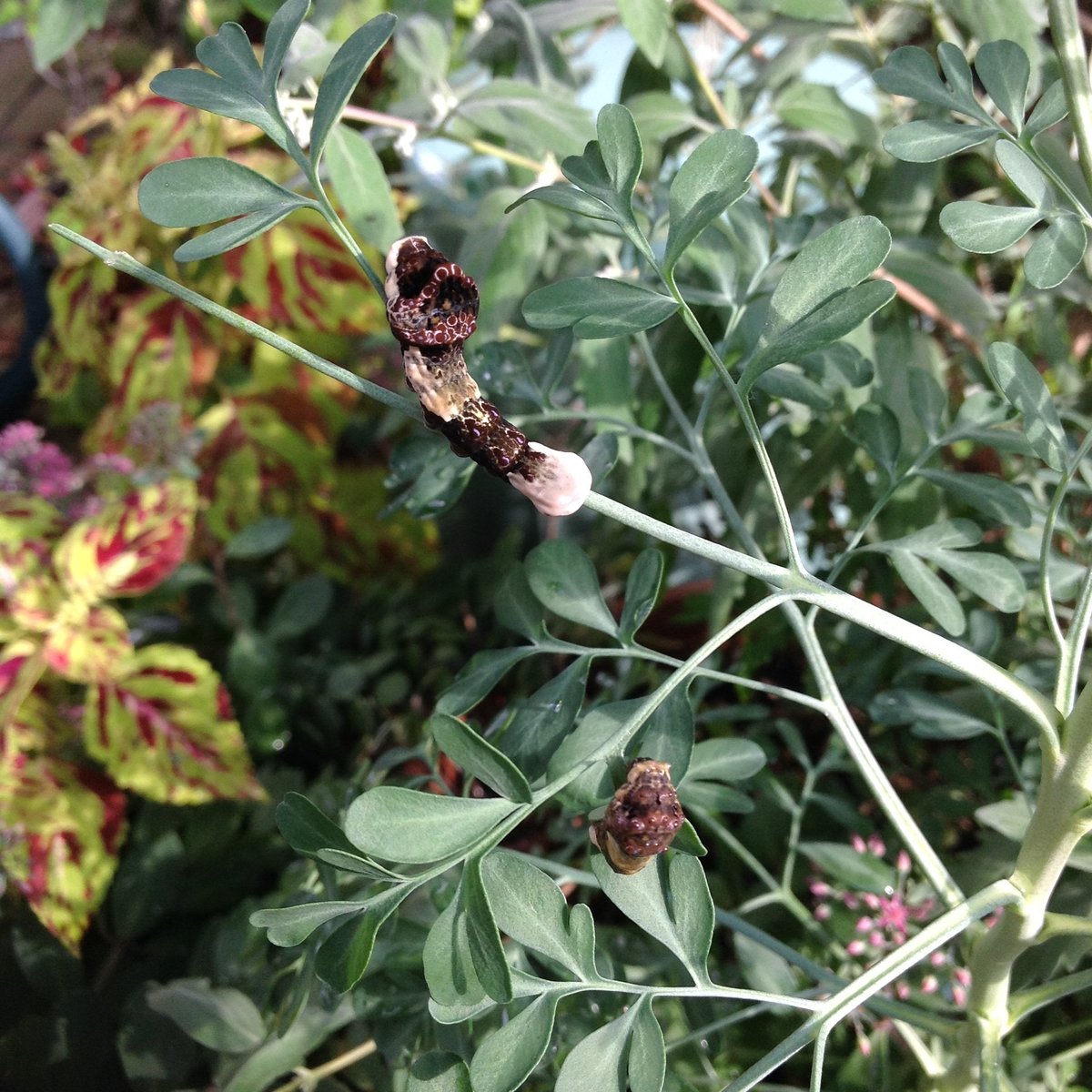
Chris Herz found four giant swallowtail cats in her garden (feeding on rue) on August 25 — a first for our log.
tiger swallowtail: Extreme dates 4/22-10/4 [previous LFOY 4/19/14]. Total reports/individuals: 168/213. (2016 totals: 814/1770)
spicebush swallowtail: Extreme dates 5/5-10/7. Total reports/individuals: 229/421. (2016 totals: 750/2186)
Palamedes swallowtail: no reports since 2015.
checkered white: Extreme dates 7/8-8/24 [previous ELOY 9/29/12]. Total reports/individuals: 2/5. (2016 totals: 14/108) Is the Nabb Rd colony disappearing? If so, this will become a tough find for our log.
cabbage white: Extreme dates 3/29 – 11/19. Total reports/individuals: 745/5073. (2016: 1804/10,415)
falcate orange-tip: Extreme dates 4/21-5/12 [previous LFOY 4/16/15]. Total reports/individuals: 27/74.
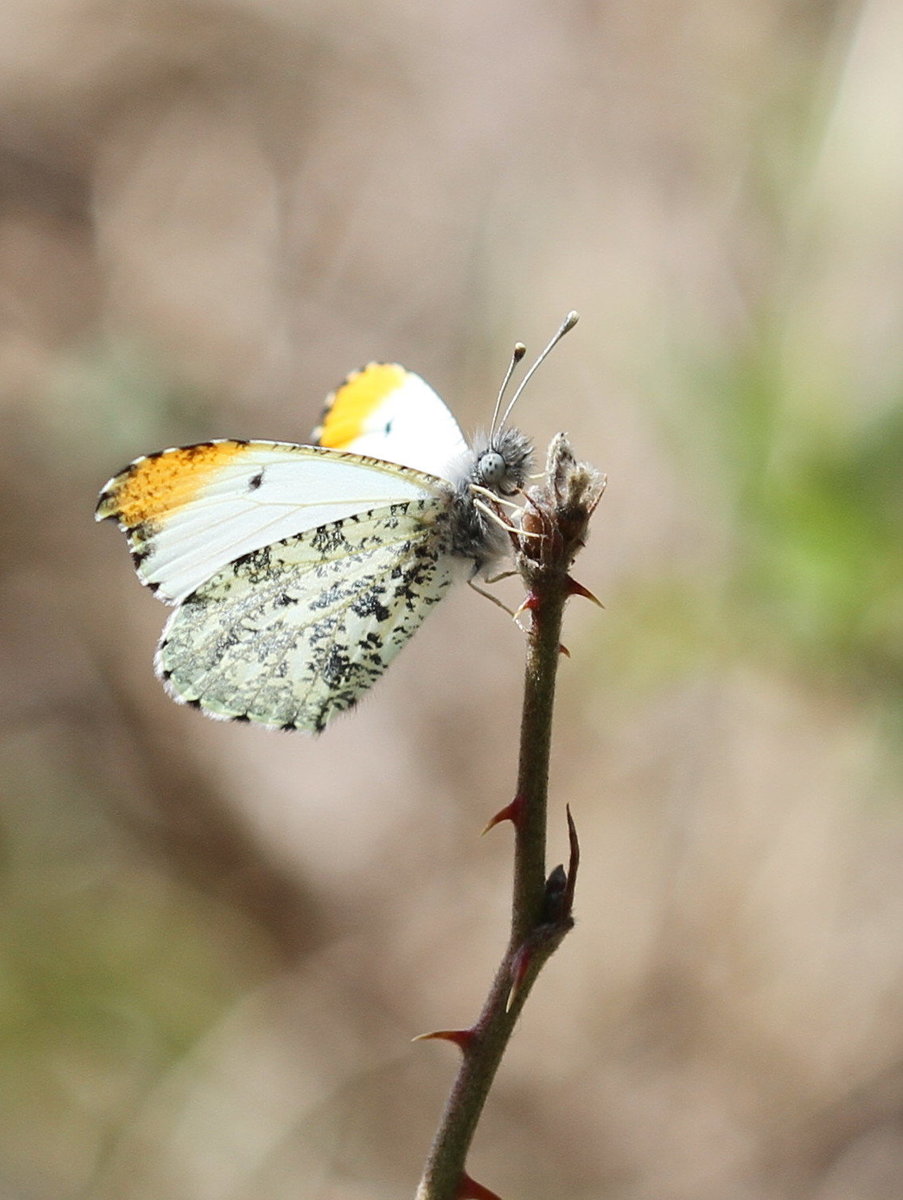
Falcate orangetips emerged on April 21, five days later than our previous LFOY. Dave Amadio photo’d this one at Riverwinds (GLO).
clouded sulphur: Extreme dates 4/12-11/1 [tied previous ELOY 11/1/12]. Total reports/individuals: 57/103. The 103 is way under what was seen as there were four reports of “a” and three reports of “c.”
orange sulphur: Extreme dates 2/28-12/29. Total reports/individuals: 239/895. Not seen is January which broke a 21-month streak. (2016 totals: 982/3925)
cloudless sulphur: Extreme dates 7/21-11/7. Total reports/individuals: 69/128. (2016: 452/1531).
little yellow: Extreme dates 8/12-10/1. Total reports/individuals: 3/14. (2016: 56/461).
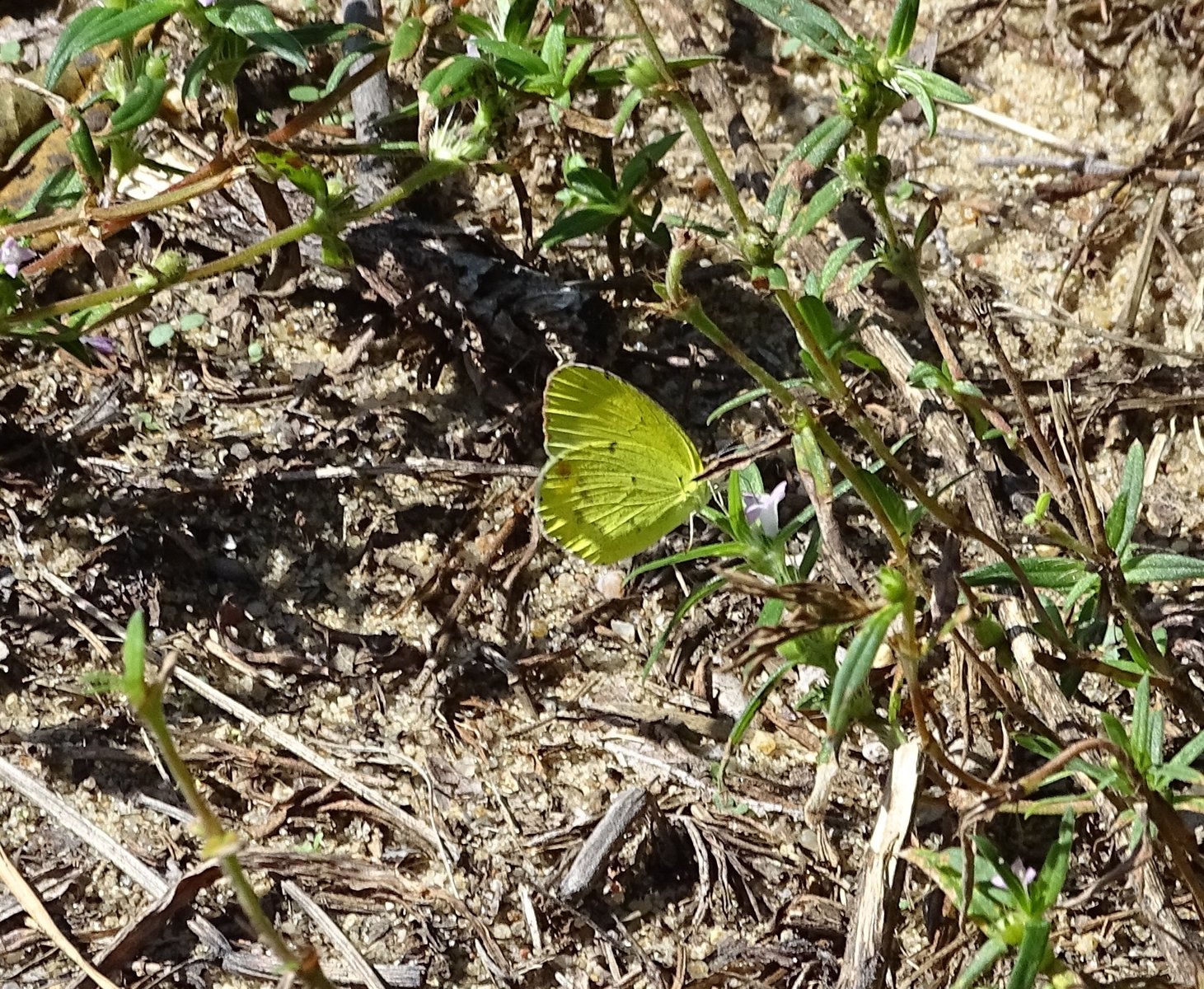
It was not a good year for little yellow, but Sandra Keller managed to photo this one at Tranquility Trail (GLO) on September 15.
sleepy orange: Extreme dates 5/15 -11/1 (new FOY). Total reports/individuals: 23/380. Peak count: 87 on 8/5. Reports from CMY (Lizard Tail and Villas) and CUM (Langley Rd). All other reports from the Dix WMA colony, resulting in a significant inflation of totals due to multiple reports of the same individuals.
harvester: Extreme dates 5/24-9/22. Total reports/individuals: 6/18. One report from Boundary Creek NRA Moorestown (BUR); other five from Chestnut Branch (GLO). Peak count 6 on 9/3.
American copper: Extreme dates 4/13-10/19. [2nd ELOY 10/18/13). Total reports/individuals: 36/97. (2016: 171/570).
bronze copper: Extreme dates 6/2-9/21. Total reports/individuals: 8/28. Peak count 11 on 6/2.
bog copper: Extreme dates 6/7-6/26. Total reports/individuals: 4/51. Totals most likely down due to fewer efforts to observe this species. (2016: from 8/108).
red-banded hairstreak: Extreme dates 5/10-10/12. Total reports/individuals: 104/187. Peak count 8 on 7/25. (2016: 358/860).
Hessel’s hairstreak: Extreme dates 5/7-5/21. Total reports/individuals: 5/16. [2nd; LFOY 5/8/15]
oak hairstreak: no reports since 2014.
coral hairstreak: Extreme dates 6/15-7/1. Total reports/individuals: 11/89.
Edwards’ hairstreak: Extreme dates 6/28-7/7. Total reports/individuals: 6/8.
banded hairstreak: Extreme dates 6/7-7/7 [2nd to ELOY 7/5/12]. Total reports/individuals: 12/32. Peak 8 on 7/7 CUM. (2016: 45/99).
striped hairstreak: Extreme dates 6/17-7/26. Total reports/individuals: 4/5. (2016: 9/20).
brown elfin: Extreme dates 4/18-5/12 [2nd to ELOY 5/10/13]. Total reports/individuals: 13/25. (2016: 30/90).
hoary elfin: Extreme dates 4/23-5/21. Total reports/individuals: 5/61. Peak “too many to count” 5/9. As usual in recent years Warren Grove OCN seems the one reliable spot for this species. Previously reported (2015 and earlier) from Lakehurst, Oswego River Preserve, Bamber Lake, and Whiting. Could it be that not enough of our team observers are finding their way to those and other areas when this butterfly still flies? Or is Warren Grove our only reliable location for this troubled species?
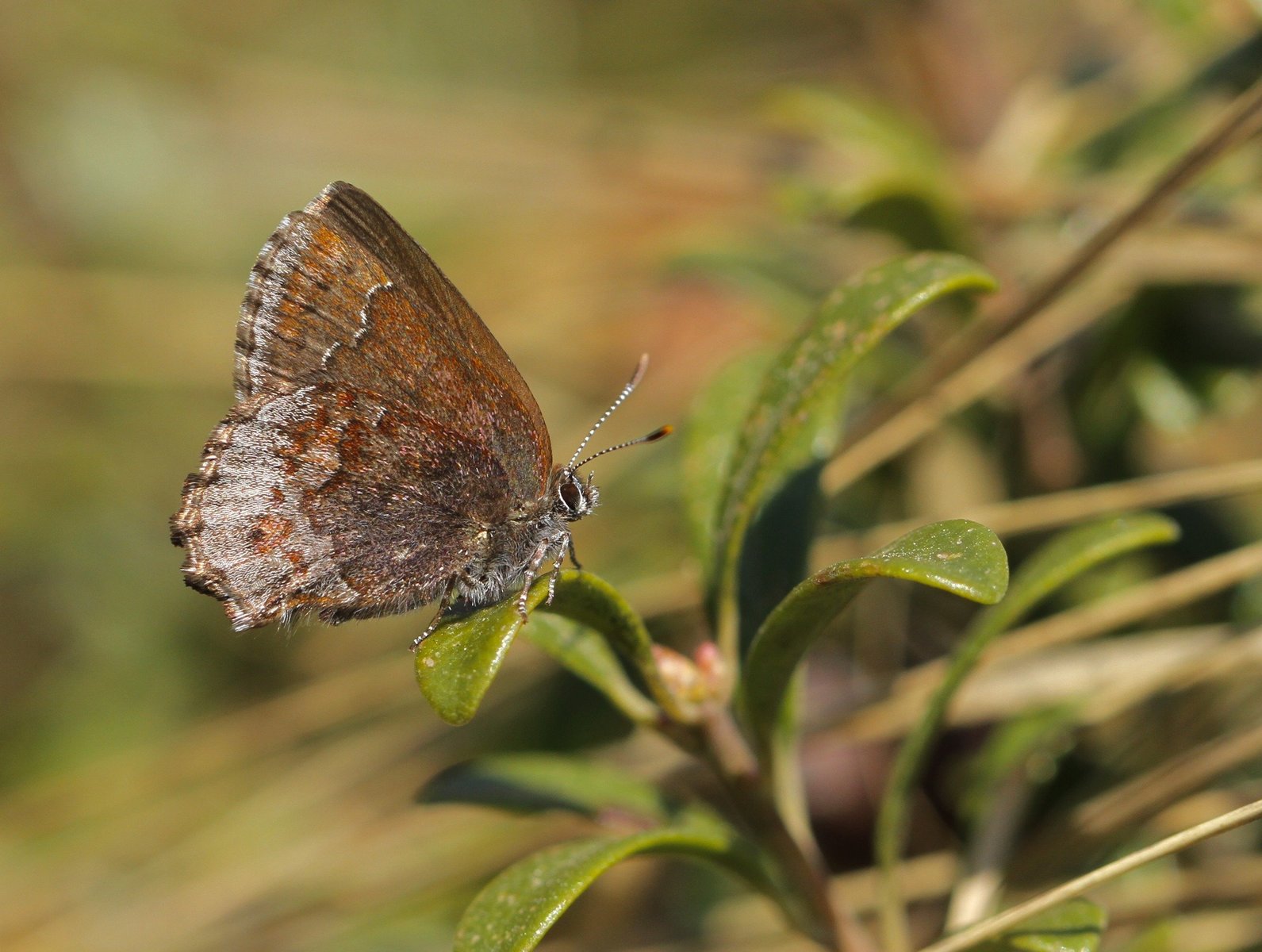
Like so many other spring species, hoary elfin emerged late. This one, photo’d by Ben Barkley at Warren Grove (OCN), was our FOY on April 23.
Henry’s elfin: Extreme dates 4/11-5/9 [previous LFOY 4/9/14; previous ELOY 5/10/17]. Peak count 13 on 4/18 Old Robbins CMY. Total reports/individuals: 23/87. (2016: 92/420).
frosted elfin: Extreme dates 5/1-5/8 [previous LFOY 4/24/13] [tie for ELOY [5/8/17]. This species was found in only two CMY locations, neither of which seems to have hosted large colonies in 2018. Total reports/individuals: 4/10. (2016: 15/78)
eastern pine elfin: Extreme dates 4/11-5/23. Total reports/individuals: 20/23. (2016: 53/95)
juniper hairstreak: Extreme dates 4/26-8/5 [previous LFOY 4/24/11]. Total reports/individuals: 21/117.
white-m hairstreak: Extreme dates 5/2-10/17 [2nd to LFOY 6/12/11]. Total reports/individuals: 18/26. (2016: 55/86).
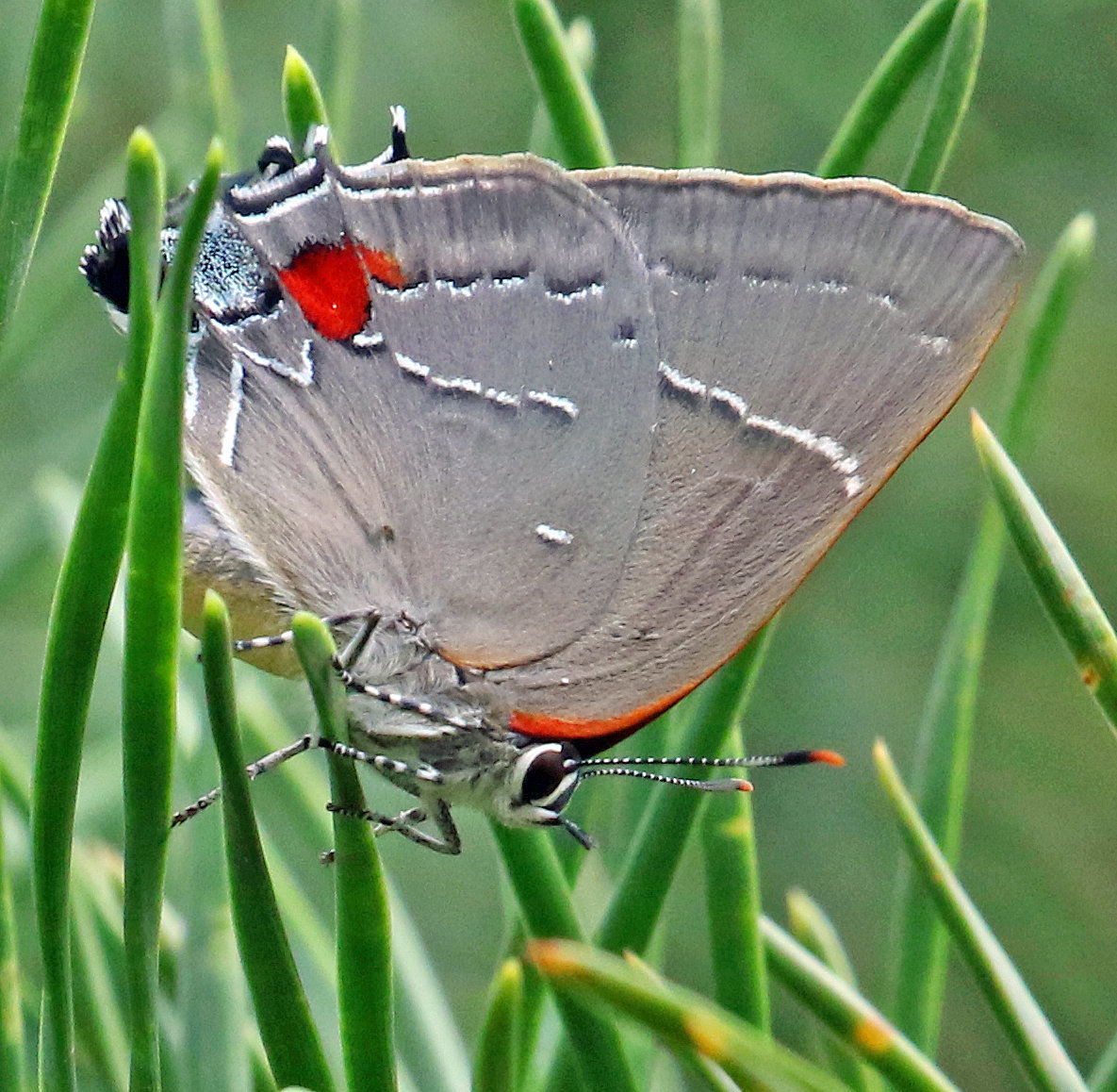
The beauty of a white M hairstreak captured up close and personal by Harvey Tomlinson on September 20 at Coxhall Creek (CMY)
gray hairstreak: Extreme dates 4/18-10/19 [previous ELOY 10/24/14]. Total reports/individuals: 197/410. (2016: 463/1063)
e. tailed-blue: Extreme dates 4/21-11/1 [2nd to LFOY 4/24/15]. Total reports/individuals: 328/1400. (2016: 982/3511).
summer azure: Extreme dates 5/12-10/4. Total reports/individuals: 200/275.
blueberry azure: Extreme dates 3/18-5/12. Total reports/individuals: 9/16. (2016: 93/982)
holly azure: Extreme dates 3/29-5/11. Total reports/individuals: 7/65. (2016: 65/551).
[“Edwards’ azure”: Extreme dates 4/28-4/28. Azure taxonomy has changed in recent years. See David Wright’s Butterflies in Pennsylvania (2017). When our log began in 2008, early-season azures with dusty underwings (“marginata” form) found ovipositing on closed buds of dogwood were possible Edwards’ azures. This individual, photographed ovipositing on Cornus alternifolia in ATL, seemed to fit that description. Wright now groups the early-season Cornus ovipositors under “spring azure,” Celastrina ladon. Total reports/individuals: 1/1.]
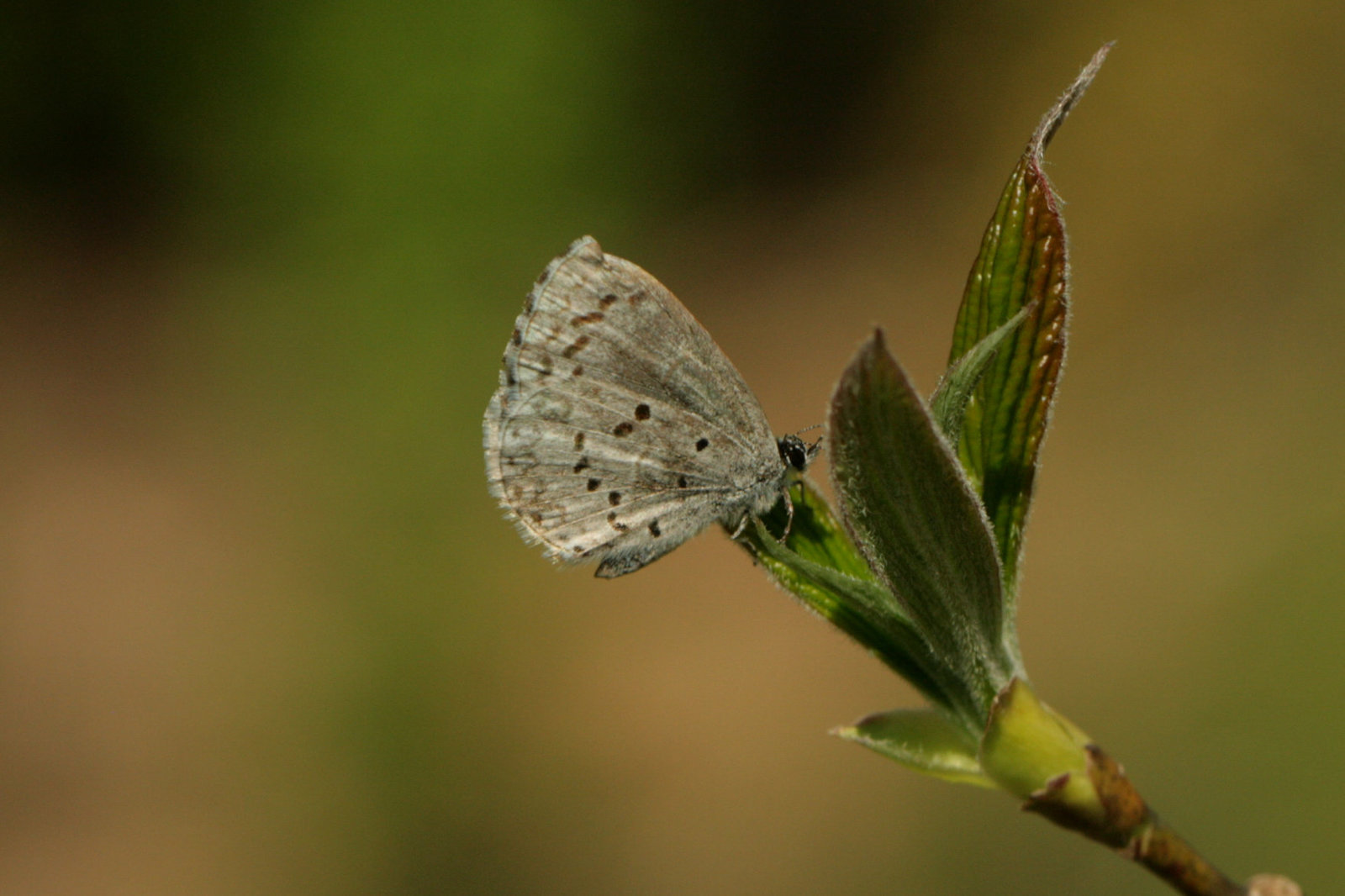
Possible “Edwards’ azure” in Port Republic garden (ATL) April 28, photo’d by Jack Connor. Other pix on the log show this individual ovipositing and a single egg. Cats were not found.
American snout: Extreme dates 3/30-11/1. Total reports/individuals: 23/30. (2016: 101/191)
variegated fritillary: Extreme dates 5/4-10/30 [2nd to LFOY 6/4/15] [ties previous ELOY 10/30/14]. Total reports/individuals: 108/288.
great spangled fritillary: Extreme dates 6/15-7/9. Total reports/individuals: 7/16.
meadow fritillary: Extreme dates 6/16-6/16. Total reports/individuals: 1/1. Often reported from several locations in SAL, but a single site in 2018.
pearl crescent: Extreme dates 5/1-11/7 [previous LFOY 4/30/15]. Total reports/individuals: 281/1195. (2016: 654/2610)
question mark: Extreme dates 2/20-12/3. Total reports/individuals: 110/153.
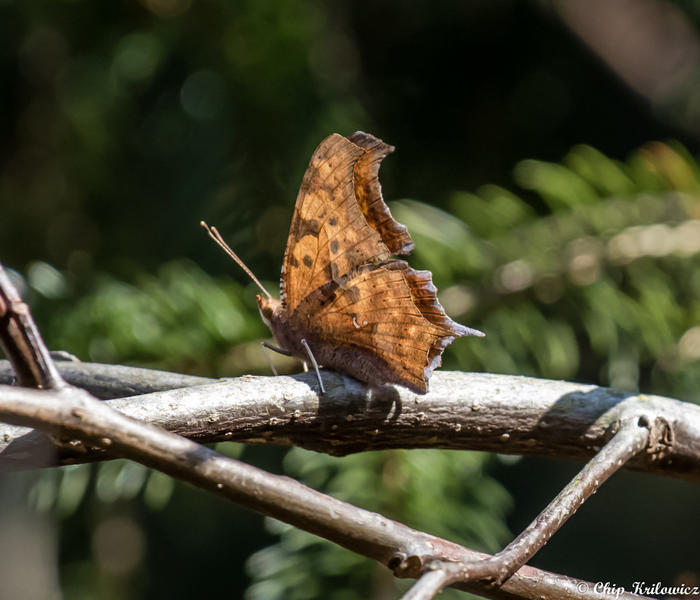
February was warmer than average — and we had 11 reports, including this question mark photo’d by Chip Krilowicz in Supawna Meadows (SAL) on Feb 20. The abnormal cold of March set in soon after.

Can you name these two species? Tom Bailey captured this delightful side-by-side shot of our two punctuation mark species at Palmyra Cove Nature Center (BUR) on July 28.
e. comma: Extreme dates 2/20-12/3. Total reports/individuals: 152/494.
mourning cloak: Extreme dates 2/20-11/19. Total reports/individuals: 34/44. (2016: 146/231)
American lady: Extreme dates 4/12-12/3. Total reports/individuals: 206/330. (2016: 694/1601)
painted lady: Extreme dates 4/23-11/7. Total reports/individuals: 37/48.
red admiral: Extreme dates 4/12-12/29 [2nd to LFOY 4/14/11]. Total reports/individuals: 200/482. (2016: 486/911)
common buckeye: Extreme dates 5/10-12/3 [previous LFOY 5/5/14]. Total reports/individuals: 276/2432. Peak count 10/3: 430 at Heislerville CUM and “100’s and 100’s” at CMPSP. The total for this species is significantly under-reported as there were nine reports of “c” and two reports of “a.”
red-spotted purple: Extreme dates 5/20-10/17 [previous LFOY 5/19/08]. Total reports/individuals: 255/379. (2016: 366/791).
[white admiral: Extreme dates 6/30-6/30. Total reports/individuals: 1/1. First report of this subspecies in log’s history.]
viceroy: Extreme dates 5/26-10/8 [2nd to LFOY 6/16/11 [previous ELOY 10/11/09]. Total reports/individuals: 85/148.
hackberry emperor: Extreme dates 6/9-10/4. Total reports/individuals: 27/34. (2016: 42/74).
tawny emperor: Extreme dates 6/15-9/15. Total reports/individuals: 14/23. (2016: 37/95)
Georgia satyr: Extreme dates 6/8-8/22 (NEW FOY). Total reports/individuals: 4/28.
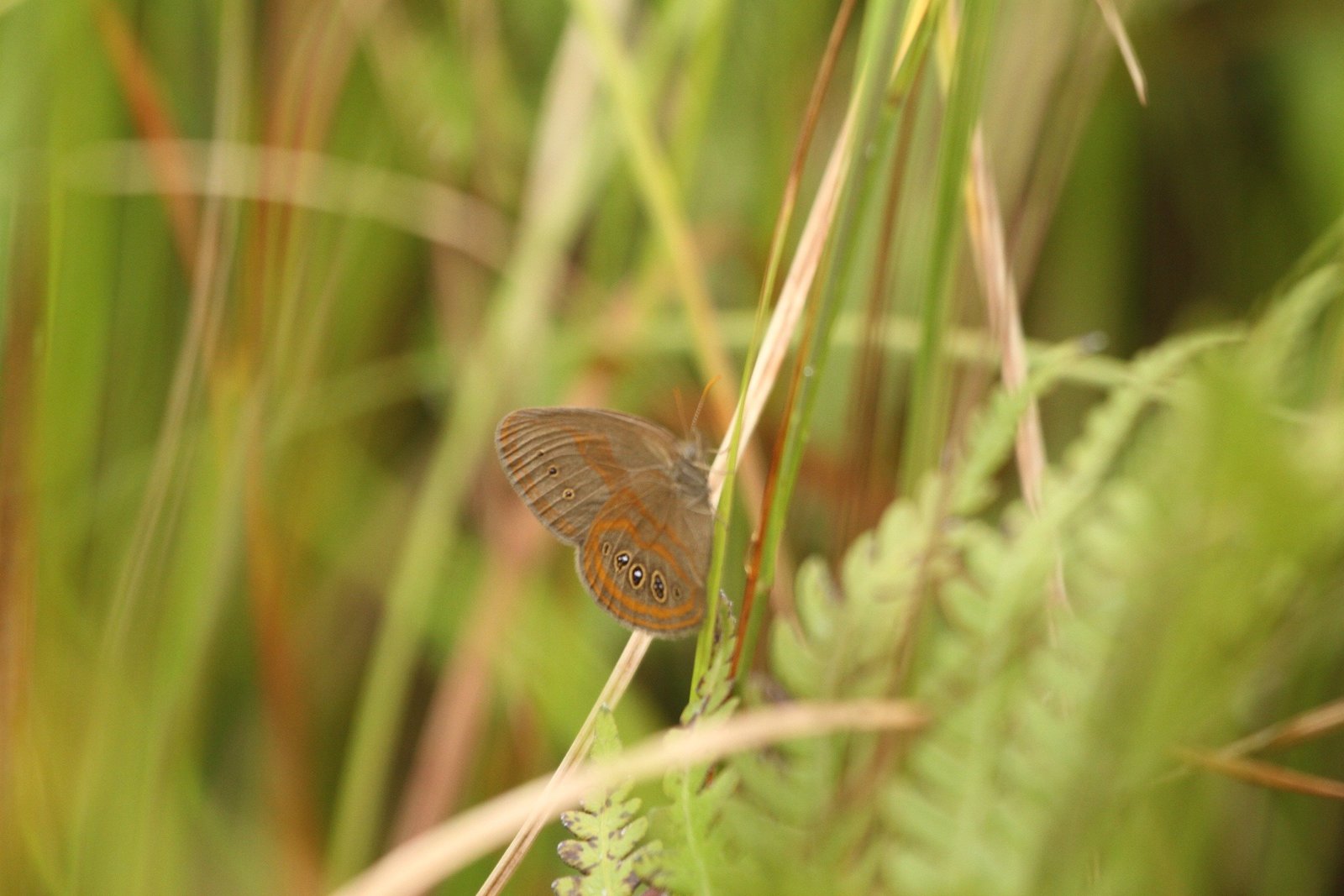
Brian Johnson photographed the first of our second brood Georgia satyrs in Wharton State Forest (BUR) on August 18.
Appalachian brown: Extreme dates 5/28-9/3. Total reports/individuals: 30/73. (2016: 57/408)
little wood satyr: Extreme dates 5/24-7/26 [previous LFOY 5/20/13]. Total reports/individuals: 46/290.
common wood nymph: Extreme dates 6/26-9/20. Total reports/individuals: 49/105. (2016: 141/267)
monarch: Extreme dates 4/22- 12/4. Total reports/individuals: 665/3323. Peak count on 10/3 when “1000’s and 1000’s” were reported by Pat and Clay Sutton (these totals are not present in this tally).
long-tailed skipper: Extreme dates 9/26-10/17. Total reports/individuals: 14/16. All reports from CMY except for 2 reports from CUM. (2016: 49/65)
silver-spotted skipper: Extreme dates 5/4-10/12. Total reports/individuals: 428/1231.
hoary edge: no reports since 2013.
s. cloudywing: Extreme dates 5/25-6/17 [previous LFOY 5/19/08]. [Previous ELOY 7/10/08]. Total reports/individuals: 4/5. Management practices at Tuckahoe WMA may be responsible for the lack of reports for this species at that location. (2016: 39/125)
n. cloudywing: Extreme dates 6/2-6/2 [previous ELOY 6/28/17]. Total reports/individuals: 1/2. See above. Again, management practices at Tuckahoe WMA may be responsible for the lack of reports for this species at that location. (2016: 14/23)
Hayhurst’s scallopwing: Extreme dates 7/28-9/14 [previous LFOY 6/2/13]. Total reports/individuals: 7/86.
sleepy duskywing: Extreme dates 4/28-6/2 (new LOY). Total reports/individuals: 8/12. 2016: 16/77
Juvenal’s duskywing: Extreme dates 4/12-5/23 [2nd to ELOY 5/20/12]. Total reports/individuals: 21/161. 2016: 123/672
Horace’s duskywing: Extreme dates 5/12-10/10 [previous LFOY 4/30/16]. Total reports/individuals: 111/193. 2016: 224/447
wild indigo duskywing: Extreme dates 4/28-10/8 [2nd to LFOY 4/29/17]. Total reports/individuals: 35/62. 2016: 67/170
common checkered skipper: Extreme dates 6/28-10/20 [previous ELOY 10/21/12]. Total reports/individuals: 31/83. 2016: 109/320
common sootywing : Extreme dates 5/2-10/9 (new LOY). Total reports/individuals: 54/111. 2016: 109/320
zabulon skipper: Extreme dates 5/14-9/21. Total reports/individuals: 215/1190.
salt marsh skipper: Extreme dates 6/9-10/10. Total reports/individuals: 57/586. 2016: 176/1346
clouded skipper: no reports since 2014.
rare skipper: Extreme dates 6/26-7/19: Total reports/individuals: 34/167.
dotted skipper: Extreme dates 6/16-6/26 [previous ELOY 6/15/16]. Total reports/individuals: 4/27. As has been the case for several years, found only in Colliers Mills (OCN). Last report elsewhere: Manumuskin River Preserve 7-9-11.
Aaron’s skipper: Extreme dates 6/5-10/10 [previous LFOY 6/3/16]. Total reports/individuals: 50/133. 2016: 107/478
swarthy skipper: Extreme dates 5/26-9/7 [2nd- to ELOY 8/31/10]. Total reports/individuals: 29/68
least skipper: Extreme dates 5/21-10/15. Total reports/individuals: 182/800.
European skipper: Extreme dates 6/2-6/2 [previous ELOY 6/3/12]. Total reports/individuals: 1/13. 2016: 7/82
fiery skipper: Extreme dates 9/15-11/4 [previous LFOY 7/24/10]. Total reports/individuals: 63/245. 2016: 197/491
cobweb skipper: Extreme dates 5/9- 5/12 [previous ELOY 5/14/17]. Total reports/individuals: 3/8. For the first time in the log’s history, this species was reported only from a single site for the year: Warren Grove, OCN.
Leonard’s skipper: no reports since 2013
Peck’s skipper: Extreme dates 5/21-10/6. Total reports/individuals: 127/266. 2016: 268/934
tawny-edged skipper: Extreme dates 6/16-10/4 [previous LFOY 5/28/08]. Total reports/individuals: 19/30. 2016: 87/206
crossline skipper: Extreme dates 6/1-9/22. [2nd to LFOY 6/3/09]. Total reports/individuals: 23/38. 2016: 70/111
n. broken dash: Extreme dates 6/15-8/20. Total reports/individuals: 39/80. 2016: 83/246
southern broken dash: After two years when observers reported [and photographed] apparent individuals of this species, we had no reports this year
little glassywing : Extreme dates 6/2-8/20 [previous ELOY 8/26/17] Total reports/individuals: 33/121.
sachem: Extreme dates 5/15- 11/7. Total reports/individuals: 419/3094. 2016: 1087/10,597
Delaware skipper: Extreme dates 5/31-9/7 (ties FOY’12 and ’17). Total reports/individuals: 36/80.
mulberry-wing: Extreme dates 6/26-7/12. Total reports/individuals: 6/73. 2016: 13/161
broad-winged skipper: Extreme dates 6/7-9/21. Total reports/individuals: 162/1557.
Dion skipper: Extreme dates: 7/12-8/22 (new LOY; old 8/20/16. Total reports/individuals: 7/41. 2016: 21/171
black dash: no reports since 2009.
two-spotted skipper : Extreme dates 6/16-6/24. Total reports/individuals: 2/2.
dun skipper: Extreme dates 5/31-9/11 [2nd to LFOY 6/4/16]. Total reports/individuals: 55/161.
dusted skipper: Extreme dates 5/11- 5/25. Total reports/individuals: 6/96. Peak count 67 on 5/21 SAL.
common roadside skipper: no reports since 2010.
Brazilian skipper: Extreme dates 5/20- 11/29. New FOY (7/15/15) and new LOY (11/5/17). Total reports/individuals: 43/57. 2018 was an invasion year for this southern species (our previous high was four reports in 2017). The species was first reported at CMPSP on 5/20 and next on 5/27, also in CMY. We had a single report in July in CUM, our first-ever from an area outside CMY, then a flurry of August reports in CMY, and our first-ever report from SAL (8/25).By August, it was clear that species was breeding throughout CMY; in fact, almost any place that had Cannas seemed to have Brazilian skippers (at least caterpillars and/or eggs). It is not possible to summarize the number of reports and individuals as many of the reports came from Beth Polvino’s garden as she thoroughly documented all phases of the Brazilian invasion: eggs, larvae, pupae, and adults.
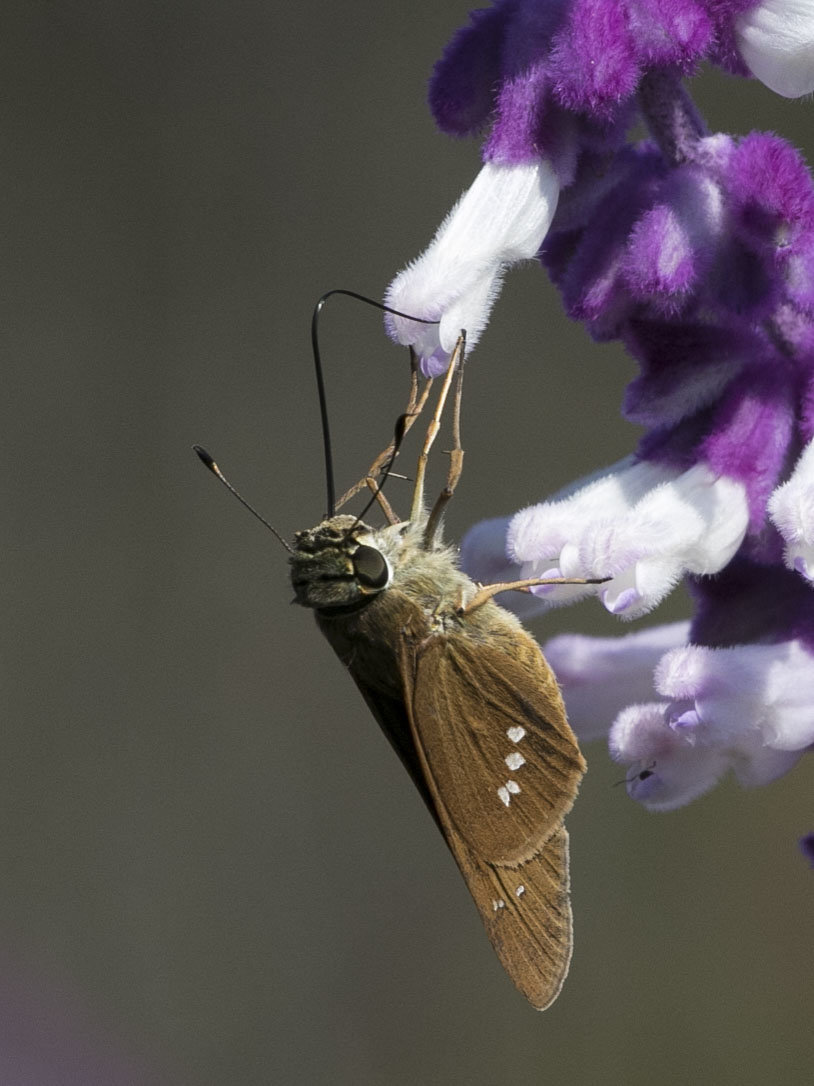
One of the many Brazilian skippers found (and often raised) by Beth Polvino in her garden in North Cape May. Beth photo’d this one on Oct 4.
Ocola skipper: Extreme dates 8/16-10/23. Total reports/individuals: 65/178. 2016: 210/528.
Thanks to all observers!
We had reports in 2018 from Cynthia Allen, Dave & Pat Amadio, Dolores Amesbury, Jesse Amesbury, Tom Bailey, Ben Barkley, Tom Baxter, Jennifer Bulava, Brenda Bruton, Claire Campbell, Jesse & Jack Connor, Deb, Doyle, & Jim Dowdell, Vince Elia, Amy Gaberlein, Sam Galick, Steve Glynn, Jean Gutsmuth, Chris Herz, Karen & Brian Johnson, Fred Kahan, Sandra Keller, Will Kerling, Teresa Knipper, Mike Lee, Brian Magnier, Alice Miller, Jack Miller, Robert Koch, Meredith Koenig, Chip Krilowicz, Beth Polvino, Tom Reed, Virginia Rettig, Mark Russell, Margaret Salvia, Linda Spangler, Jim Springer, Richard Stickney, Pat & Clay Sutton, Jon Sutton, Eric Todd, Harvey Tomlinson, Sharon & Wade Wander, Matt Webster, and C. Wyluda. (Let us know if we forgot anyone!)
Thanks to each of you and all of you.
Keep at it in 2019, everyone!
Jack Miller and Jack Connor.

